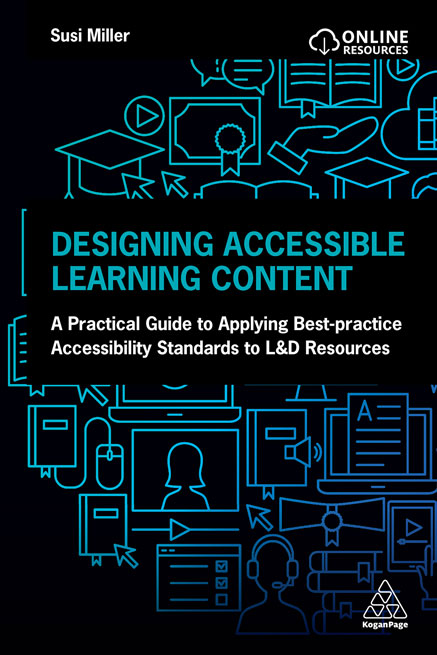Key features
- Provides expert guidance on how to make L&D content accessible and aligned with Web Content Accessibility Guidelines (WCAG)
- Facilitates applying accessibility standards to eLearning content through a unique contextual framework designed specifically for online learning content created using any authoring tool
- Includes learner case studies and industry perspectives, explaining essential background information
- Focuses on different types of disability, designing for assistive technology and the case for digital accessibility
- Demonstrates how L&D professionals can address tool limitations, produce meaningful accessibility statements and tackle testing requirements
- Online resources: Checklists which can be adapted to suit a range of authoring tools and ways of working
Industry reviews
This is the book I wish I had read 15 years ago. It would have saved me an enormous amount of time having to learn things a harder way. Susi’s wisdom has been distilled from experience; from trying to improve her own practice, shift her own skill set, learn from end users, and learn from other professionals. That gives the book authenticity. It doesn’t pretend that digital accessibility is always an easy process, but it offers a pragmatic approach which makes it achievable for everyone.
This book will take you on a journey through digital accessibility. From a professional point of view, it might be the most important journey you embark on.
Alistair McNaught
Director, Alistair McNaught Consultancy Ltd
This is an invaluable guide for L&D practitioners giving the how and why of making learning content accessible. It brings together an extensive range of resources and practical advice in one place, and will likely become a standard work in our field.
Donald H Taylor
Chair, Learning Technologies Conference
Susi combines her own and others’ lived experience into an empathy-fuelled work that creates clarity and removes barriers for anyone seeking to understand why and how to produce accessible learning content. Her book has a compelling and comprehensive approach to digital accessibility and disability inclusion, which really brings the subject to life. This is recommended reading for any professional, producing digital content.
Michael Vermeersch
Digital Inclusion Lead Microsoft
I know from working with Susi through the eLearning Network that she is not only passionate about accessibility in eLearning design but also extremely knowledgeable about what is required by those of us creating eLearning. It comes as no surprise that she’s made this book accessible in the way she’s structured it and the language she uses! This will surely become a ‘must read’ for all eLearning professionals: after all, making better learning experiences for all learners is what we are (or should be) all about!
Joan Keevill
Director, Designs on Learning and Chair of the eLearning Network
I wish I had this book when I started working with accessible eLearning. Susi Miller does a fantastic job of showing why eLearning professionals need to ensure that their training needs to be accessible, while also providing, through the eLearning accessible framework that she proposes, a practical way of making it happen. I’m looking forward to putting what I learned here into practice and recommending the book whenever I’m discussing elearning and accessibility.
Kevin Gumienny
Senior Consultant at Guidehouse
Digital accessibility can be a tough and technical subject to tackle, but Susi has broken down complex guidelines and carefully brought them to life through using her personal learning journey, practical examples and how-to illustrations. It is an essential read for any eLearning practitioner.
Grant Broome
Digital Inclusion Strategist and Director DIG Inclusion Ltd.
Designing Accessible Learning Content is a unique and much-needed resource for L&D practitioners struggling with the complexities of eLearning accessibility. The wealth of background knowledge it provides, combined with practical frameworks, clear explanations and examples make this a vital handbook for anyone who believes that designing inclusive learning content is the right thing to do.
Dr Nasser Siabi OBE
CEO Microlink PC
Before Instructional Designers understand how to develop accessible eLearning, they often fall back on providing a written course transcript. However, armed with modern eLearning authoring tools and the information found in this book, author Susi Miller suggests that “as eLearning professionals become more familiar with designing accessible content, they find ways of making all learning content inclusive without needing to provide accessible alternatives (emphasis mine).” If you aspire to develop universally accessible eLearning, look no further than this comprehensive, plain language guide.
Chris Willis
Director of Product, Lectora, eLearning Brothers
At a time where everything is changing, acquiring new skills is of paramount importance. Now more than ever learning is being delivered online and remotely. If we want everyone to have an equal chance of acquiring new skills learning content needs to be accessible. In this book Susi demystifies and explains what learning and development professionals need to know in order to make their content work for the widest possible learner base. The work recognises the difference between standard web content and learning materials and offers practical and pragmatic advice on accessible content creation.
Neil Milliken
Global Head of Accessibility (Atos Group) at Atos





Recent Comments